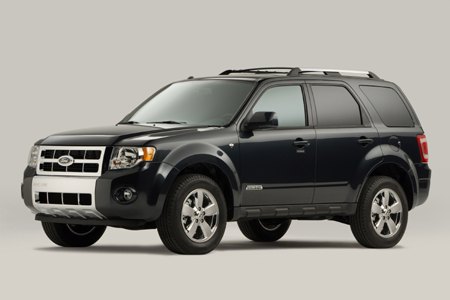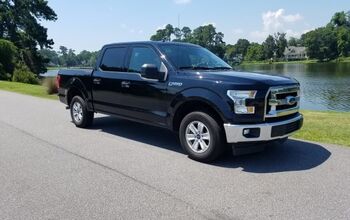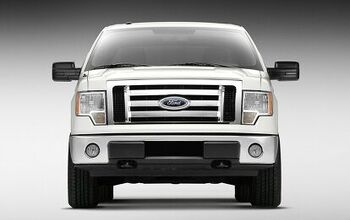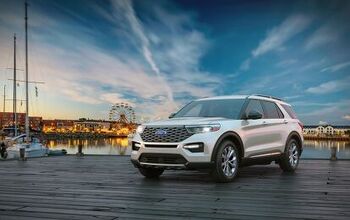Ford Escape XLT 4WD Review

In an era where Explorers are MIA and Expeditions can't make it out of base camp, Ford's cute ute is a mission-critical machine. If Ford's going to Escape its financial woes, their compact SUV has to at least keep the lights on. To find out if the new Ford Escape is "the end to boredom" (as the website proclaims) or simply "the end of the line," I ran America's most popular softroader up the Adirondacks, down the interstate, into Manhattan traffic and ‘round the ‘burbs.
Now that Honda's gotten edgy with the CR-V and Toyota's RAV-4 is too intelligent to be classified (says them), Ford opted to cowboy-up the Escape. To that end (front?), Ford added a shiny new chrome grill, hood and headlights; rounder wheel arches and new taillights– all designed to link the Escape to the Explorer. And there you have it: the Ford Five Hundred of SUV's. Or, as Ford puts it, "One look and you know it's built for people on the move."
Escaping the exterior's old ennui for the Escape's cabin is like putting your accountant on hold so you can talk to your tax attorney. Even if you forgive the interior's blandness as a reflection of the brand's utilitarian remit, the cost-cutting measures used to create the Escape's aesthetic sterility are both obvious and extreme. The center stack's plastic knobs are almost whimsically flimsy.
Ford is trumpeting the fact that all the Escape's controls respond with the exact same tactile feedback (a la Audi). This "switch-feel uniformity" is an admirable achievement for a mass market automaker. But it couldn't overcome the fact that the interfaces involved are made of plastic that Fisher Price wouldn't inflict on its core clientele. I might have been more impressed if the Escape's controls hadn't been arranged with meaningless uniformity (the volume knob is the same size and shape as the fan control) and mind-numbing symmetry.
The rest of the Escape's dash offers more of the same, with a ho-hum set of dials and a steering wheel made of materials that only a company that lost $9b in a fiscal quarter would dare use. I'm willing to tolerate cheap plastic where fingers fear to tread, but I can't abide nasty shifters and steering wheels that offer only slightly more haptic happiness than 150 grit sandpaper.
My steed was equipped with Ford's ancient and venerable 3.0-liter Duratec V6. With 193 horses motorvating 3547 pounds (plus driver), the powerplant proved both smooth and acceleratively adequate: slow but not sluggish. On the highways, the Escape attained 80mph quite easily, even considering the extra weight of the 4WD components. In the mountains, where the car was obliged to ascend gen-u-ine gradients, the engine's shortcomings were obvious.
On anything resembling a moderate slope, the Escape's four-speed autobox had to downshift to maintain speed. The puff problem reminded me of an underpowered Focus that I guided through the Albertan Rockies; I guess these things run (walk?) in the family. I can only imagine how hard that little Duratec would have to work to haul an entire crew, their luggage, whatever's on the roof rack and a bass boat (tow rating: 3500 lbs.) up those hills. Anyone attempting the same feat in the base model's 2.3-liter four would find themselves going nowhere slow.
The Escape's ride was reasonably compliant and its handling acceptable, though not class-leading in either respect. As with most SUVs, it's best to stay south of 80 mph in a straight line and avoid corners. On the upside, the 4WD Escape scythed through a light snow in upstate New York without any problems, which could well be the whole point of this exercise.
My tester stickered at $28k. That puts the Escape in a neighborhood crowded with well-established, highly evolved cute ute competition. After having driven the field I can report that the Escape isn't as refined or practical as the Japanese, as cheap as the Koreans, as hardcore as the German-Americans or as sexy as a packet of processed cheese. While the Escape is not so bad as to provoke derision, neither does it float to the top of the discerning buyer's list. The Escape is average in every way one can possibly imagine.
Except, perhaps, affordability. Let's face it: the Escape isn't destined to remain at that price point for long. Once a prison break of '08 Escapes clear the sales floor, it's only a matter of time before low-cost financing, dealer cash, customer incentives, employee pricing, special lease deals, etc. work their usual magic on the Escape's bottom line. At some point, it'll be one of the (if not the) cheapest vehicles in its class. At that point, I'd still rather be driving something else.

Latest Car Reviews
Read moreLatest Product Reviews
Read moreRecent Comments
- Jeff Self driving cars are not ready for prime time.
- Lichtronamo Watch as the non-us based automakers shift more production to Mexico in the future.
- 28-Cars-Later " Electrek recently dug around in Tesla’s online parts catalog and found that the windshield costs a whopping $1,900 to replace.To be fair, that’s around what a Mercedes S-Class or Rivian windshield costs, but the Tesla’s glass is unique because of its shape. It’s also worth noting that most insurance plans have glass replacement options that can make the repair a low- or zero-cost issue. "Now I understand why my insurance is so high despite no claims for years and about 7,500 annual miles between three cars.
- AMcA My theory is that that when the Big 3 gave away the store to the UAW in the last contract, there was a side deal in which the UAW promised to go after the non-organized transplant plants. Even the UAW understands that if the wage differential gets too high it's gonna kill the golden goose.
- MKizzy Why else does range matter? Because in the EV advocate's dream scenario of a post-ICE future, the average multi-car household will find itself with more EVs in their garages and driveways than places to plug them in or the capacity to charge then all at once without significant electrical upgrades. Unless each vehicle has enough range to allow for multiple days without plugging in, fighting over charging access in multi-EV households will be right up there with finances for causes of domestic strife.






































Comments
Join the conversation
So far, I have no complaints in my Ford. It’s running very well. The parts are tough. I make it a point to check every single part so as to avoid any problem in the road. Hopefully, I haven’t had any trouble with it during rush. I got to replace some its Ford Catalytic Converter and I’m fortunately enough that it’s only the part that I needed to purchase for it this month.
After reading the dozens and dozens of comments, I have to wonder what some people are smoking? I've driven many Fords over the years (Dad's a retired Ford man). I've also owned a couple of Hondas, a Buick, and an AMC (no laughter). So I've been around the block a few times with different manufacturers and test driven a lot of cars just to see how they run. Some Points: * People called the Escape utilitarian in look and "aging drag queen." You've got to be kidding. The vehicle isn't that old. Introduction Facts: 1996 Rav4 1997 CRV 2001 Escape (and Tribute) 2001 Santa Fe 2002 Liberty It's still an evolving vehicle (do people complain similarly about the ancient Accords and Camrys?). It's now got a very respectable hybrid in its line that is making in-roads where other hybrids haven't and can't. I think the recent '08 cosmetic changes have only made it better looking. * People called the Escape "underpowered." That's just plain ridiculous. I've driven the '07 Escape XLT FWD with the 3.0L and it's waaaay overpowered. If you can squeal the tires of a FWD vehicle, then it's got more power than it ought to. The 2.3L is really more than adequate for most normal driving conditions (outside of steep mountains). Plus, the '08 2.3L automatic averages 20/26 mpg (manual 22/28)which is pretty good for its size. * People called the Escape "overpriced." Well nobody should pay list price. But even at list, a 2.3L FWD XLT list for around 19-22k. That's pretty good for that size and capable of a vehicle. Incentives will drop that even more which is far better than you'll ever see from Honda's pricing. I'm not being a cheerleader here but I just couldn't stand to listen to some of the unfounded slamming of the vehicle. It just doesn't deserve it.